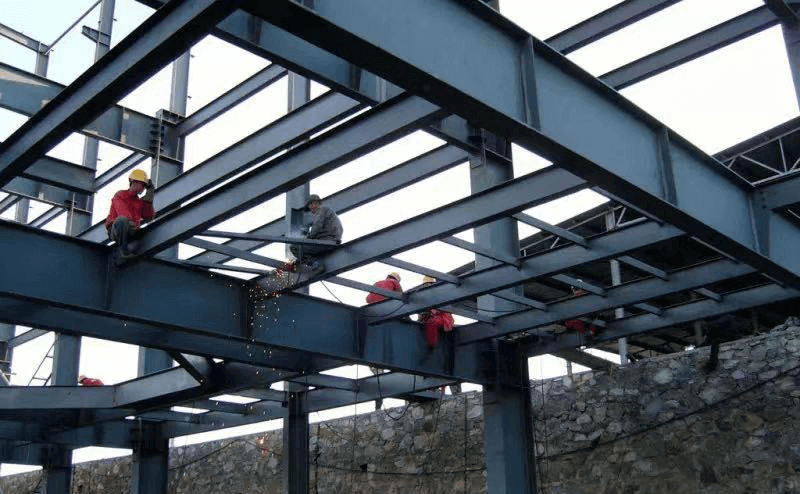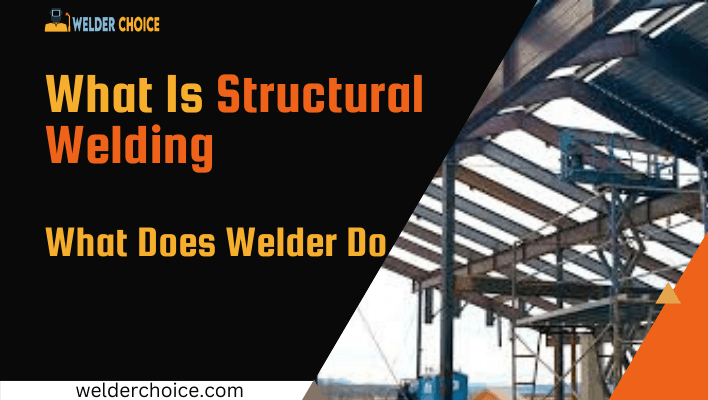Have you ever wondered what is structural welding? how does it work? And what does it entail to be a structural welder?
For the purpose of designing, fabricating, and erecting welded structures, structural welding entails a wide range of welds using various component materials. There are specific codes, designs, and weld joint types for structural welding.
To be effective, structural welders need a certain set of abilities involving accurate measurements and balance. I’ll discuss a number of topics relating to structural welding, its needs, and its outcomes in this essay.
What Is Structural Welding and Where It Use
Structural Welding is used in Metal frames for buildings, bridges, automobiles and many other intricate structures. Beams, columns, and girders can also be cut and repaired using structural welding.
Other industries like Construction, manufacturing, shipbuilding, mining, oil and gas distribution, automobile manufacture, aerospace, military, and heavy industries are just a few of the industries that use structural welding.
Welding Processes for Structural Welding

As Compared to most other metals, it offers significantly superior durability and stress tolerance.
Another advantage is that it is quite lightweight when compared to metals like iron and aluminum. Steel is also quite affordable.
Stick welding, stud welding, and flux core arc welding are the three basic types of welding procedures used in steel structural welding.
Stick welding
Shielded metal arc welding is another name for stick welding (SMAW). It is the most popular method of steel structural welding.
In this technique, the metal that needs to be welded is connected to a flux-coated consumable electrode by an arc.
The molten weld puddle is covered with flux, which is made of a mineral-based component to shield it from the elements. Once the weld cools off and solidifies, the slag layer is removed with a chipping tool or a wiring brush.
To link together two metal elements, such as steel, to construct more complicated structures, SMAW welding is utilized. Stick welding uses an electric current that can be either AC or DC.
Stick welding is considered the most simple and most inexpensive sort of welding process for building steel structures. Due to its simplicity, this welding procedure is preferred by a large portion of the metal fabrication and welding sector.
Stick welding has various advantages for building structures, including:
- Both indoors and outdoors can be employed with this welding procedure.
- When compared to other kinds of structural welding procedures, stick welding is less expensive.
- It provides a wide range of welds.
- Aside from steel, SMAW can be applied to many other types of metal.
- With stick welding, many electrodes can be utilized.
Stud welding
Steel structures are also constructed using stud welding. Another name for this procedure is drawn arc stud welding (DASW).
In this technique, the welding procedure secures a fastener or stud to a base metal. The fastener is available in a variety of shapes, including tapped, threaded, and unthreaded.
The stud welding technique makes use of a particular kind of flux. Steel, stainless steel, aluminum, and other materials are only a few examples of the many possible materials that can be used for the fastener and substrate.
Additionally highly common for producing more intricate metal structures is stud welding.
Due to the following reasons, structural welders choose stud welding:
- You don’t need access to the other side because this form of welding is only done on one side. This is occasionally your only choice.
- Stud welding is a very safe process. A DASW joint is a full cross-sectional weld, as opposed to peripheral welds that are used to secure bolts.
- A structural weld is superior to a stick weld in terms of the aesthetic aspects. There might be no signs that you fastened a fastener from the other side since you only need to use a fastener on one side.
- Stud welding is simple to learn and doesn’t call for any specialized knowledge.
- Compared to other methods of structure creation, stud welding is speedier. It takes around one second to weld a 3/4″ fastener.
The following industries use the stud welding technique:
- bridges, buildings, and construction sites
- companies that control cable
- Businesses that provide food services include coffee shops, salad bars, bakeries, restaurant griddles, etc.
- power supply apparatus
- applications in the military, shipbuilding, and aviation
- manufacturing of moving vehicles for use in agriculture, transportation, and other industries
Flux-Core Welding
Complex structures are made using the electric or semi-automatic welding technology known as flux-core arc welding (FCAW). Because both processes employ the same kind of filler wire as an electrode for the arc, they are practically comparable to MIG welding.
Instead of using shielding gas, the technique uses the flux itself to coat and shield the weld pool. Additionally, the coating allows the weld puddle more time to cool, strengthening the weld.
FCAW is quite simple to operate since it uses a machine to continuously feed the electrode into the weld puddle. Because it has a greater weld metal deposit rate, this method of welding is more advantageous for dense welding sections of a structure that are at least one inch thick.
- There is no need for an additional shielding gas for flux core welding.
- Even in windy circumstances, it is perfect for welding outdoors
- Compared to flux core welding, other structural welding methods have a larger likelihood of porosity.
- FCAW is all about placement when the appropriate filler material is available; it is simple to learn and use.
- Industries that need high-speed, reliable welding frequently use flux-core welding.
- Flux core welding is more frequently utilized in heavy industries like building and public works construction because it offers high penetration and is perfect for outdoor applications.
Structural Welding Field Vs. Shop
Both a field and a workshop can be used for structural welding. When doing on-site welding outdoors, you must take into consideration a variety of factors, including wind, height, and work angle.
The necessity to prepare the structure so that it can be transported to the site makes welding in the shop challenging.
Field Structural Welding
Due to their comfort level with stick welding, the majority of seasoned welders choose to use it for outside projects. But moving to FCAW can actually boost productivity.
Without the use of shielding gas, FCAW welding produces deep welds that can be perfect for a building site.
Stick welding is very sluggish even though it is a common method and welders like it since it is more portable. The filler sticks will need to be replaced frequently.
Because of this, switching to FCAW wire welding could be much more effective when a structural welding task in the field calls for a lot of welding in one spot.
Using a combination of stick and FCAW welding on the same project may be more efficient in some field structural welding applications. Stick welding should be used to complete small welds distributed over a big area while flux core machines should be used for areas that require more welding at a single location.
Shop Structural Welding
Due to their simplicity of use and all-position capabilities, FCAW and stud welding are both beneficial for structural metal welding applications in the shop. You don’t require a lot of ability in running the equipment.
To apply the arc, you must have accurate structure blueprints, a working knowledge of welding regulations, and a level head.
Both techniques are advantageous for structural welders of various skill levels because of these characteristics. Particularly the flux welding wires have a very wide operating range and perform admirably.
They allow you a lot of leeways, and even erratic methods can finish the work swiftly.
Stud welding may be the best option for in-shop work if you want to get a smoother finish. These welding methods can also be applied to dirtier base metals without the necessity for cleaning.
In between passes and once the welded structure is complete, slag and splatter generated by stud and FCAW welding must be cleaned up. Additionally, the shop floor may become clogged with slag, necessitating frequent cleaning.
For welders who have only done stick welding in the shop, this could seem unfamiliar.
Summary
I gave a quick overview of structural welding and the many methods for creating and joining structures. We also looked at the variations between welding structures indoors and outdoors on the structure construction site.
FAQs

With 8 years of experience a senior welding instructor and safety equipment researcher and writes articles, reviews and guidelines on helmets and other welding and safety gears at Welder Choice, and other written works have been published in various publications.
